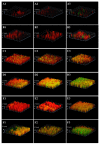Effect of the Biofilm Age and Starvation on Acid Tolerance of Biofilm Formed by Streptococcus mutans Isolated from Caries-Active and Caries-Free Adults
- PMID: 28358306
- PMCID: PMC5412299
- DOI: 10.3390/ijms18040713
Effect of the Biofilm Age and Starvation on Acid Tolerance of Biofilm Formed by Streptococcus mutans Isolated from Caries-Active and Caries-Free Adults
Abstract
Streptococcus mutans (S. mutans) is considered a leading cause of dental caries. The capability of S. mutans to tolerate low pH is essential for its cariogenicity. Aciduricity of S. mutans is linked to its adaptation to environmental stress in oral cavity. This study aimed to investigate the effect of biofilm age and starvation condition on acid tolerance of biofilm formed by S. mutans clinical isolates. S. mutans clinical strains isolated from caries-active (SM593) and caries-free (SM18) adults and a reference strain (ATCC25175) were used for biofilm formation. (1) Both young and mature biofilms were formed and then exposed to pH 3.0 for 30 min with (acid-adapted group) or without (non-adapted group) pre-exposure to pH 5.5 for three hours. (2) The mature biofilms were cultured with phosphate-buffered saline (PBS) (starved group) or TPY (polypeptone-yeast extract) medium (non-starved group) at pH 7.0 for 24 h and then immersed in medium of pH 3.0 for 30 min. Biofilms were analyzed through viability staining and confocal laser scanning microscopy. In all three strains, mature, acid-adapted and starved biofilms showed significantly less destructive structure and more viable bacteria after acid shock than young, non-adapted and non-starved biofilms, respectively (all p < 0.05). Furthermore, in each condition, SM593 biofilm was denser, with a significantly larger number of viable bacteria than that of SM18 and ATCC25175 (all p < 0.05). Findings demonstrated that mature, acid-adapted and starvation might protect biofilms of all three S. mutans strains against acid shock. Additionally, SM593 exhibited greater aciduricity compared to SM18 and ATCC25175, which indicated that the colonization of high cariogenicity of clinical strains may lead to high caries risk in individuals.
Keywords: Starvation; Streptococcus mutans; aciduricity; biofilm formation; confocal laser scanning microscopy.
Conflict of interest statement
The authors declared no conflict of interest.
Figures



Similar articles
-
Influence of starvation and biofilm formation on acid resistance of Streptococcus mutans.Oral Microbiol Immunol. 2001 Feb;16(1):24-7. doi: 10.1034/j.1399-302x.2001.160104.x. Oral Microbiol Immunol. 2001. PMID: 11169135
-
Cell density modulates acid adaptation in Streptococcus mutans: implications for survival in biofilms.J Bacteriol. 2001 Dec;183(23):6875-84. doi: 10.1128/JB.183.23.6875-6884.2001. J Bacteriol. 2001. PMID: 11698377 Free PMC article.
-
Effect of arginine on the growth and biofilm formation of oral bacteria.Arch Oral Biol. 2017 Oct;82:256-262. doi: 10.1016/j.archoralbio.2017.06.026. Epub 2017 Jun 24. Arch Oral Biol. 2017. PMID: 28668766
-
Polyketides/nonribosomal peptides from Streptococcus mutans and their ecological roles in dental biofilm.Mol Oral Microbiol. 2024 Oct;39(5):261-269. doi: 10.1111/omi.12451. Epub 2024 Jan 11. Mol Oral Microbiol. 2024. PMID: 38212261 Review.
-
[Secondary metabolites from Streptococcus mutans and their ecological roles in dental biofilm].Sheng Wu Gong Cheng Xue Bao. 2017 Sep 25;33(9):1547-1554. doi: 10.13345/j.cjb.170046. Sheng Wu Gong Cheng Xue Bao. 2017. PMID: 28956400 Review. Chinese.
Cited by
-
Biofilm models in endodontics-A narrative review.J Conserv Dent. 2021 Jan-Feb;24(1):2-9. doi: 10.4103/JCD.JCD_621_20. Epub 2021 Jul 5. J Conserv Dent. 2021. PMID: 34475672 Free PMC article. Review.
-
Effects of Caries Activity on Compositions of Mutans Streptococci in Saliva-Induced Biofilm Formed on Bracket Materials.Materials (Basel). 2020 Oct 26;13(21):4764. doi: 10.3390/ma13214764. Materials (Basel). 2020. PMID: 33114489 Free PMC article.
-
Antibiofilm effect of C-10 massoia lactone toward polymicrobial oral biofilms.J Adv Pharm Technol Res. 2021 Jan-Mar;12(1):89-93. doi: 10.4103/japtr.JAPTR_105_20. Epub 2021 Jan 9. J Adv Pharm Technol Res. 2021. PMID: 33532362 Free PMC article.
-
Inactivation efficacy of atmospheric air plasma and airborne acoustic ultrasound against bacterial biofilms.Sci Rep. 2021 Jan 27;11(1):2346. doi: 10.1038/s41598-021-81977-z. Sci Rep. 2021. PMID: 33504900 Free PMC article.
-
In-vitro effect of a single application of CPP-ACP pastes and different fluoridated solutions on the prevention of dental caries around orthodontic brackets.Dental Press J Orthod. 2024 Jan 8;28(6):e2321383. doi: 10.1590/2177-6709.28.6.e2321383.oar. eCollection 2024. Dental Press J Orthod. 2024. PMID: 38198388 Free PMC article.
References
MeSH terms
Substances
LinkOut - more resources
Full Text Sources
Other Literature Sources
Molecular Biology Databases

